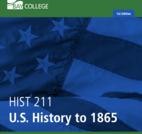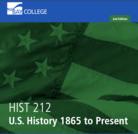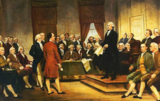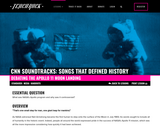
This inquiry kit features Library of Congress sources and focuses on four of Abraham Lincoln's key speeches.
- Subject:
- Social Science
- Material Type:
- Primary Source
- Provider:
- PBS Learning Media
- Date Added:
- 03/22/2024

This inquiry kit features Library of Congress sources and focuses on four of Abraham Lincoln's key speeches.

Online OER text created for U.S. History to 1865 by Dr. June Klees for Bay College.
© 2017 Bay College and Content Creators. Except where otherwise noted this work is licensed under the Creative Commons Attribution 4.0 International License. To view a copy of this license, visit http://creativecommons.org/licenses/by/4.0/.

Online OER text created for U.S. History 1865 to Present by Dr. June Klees for Bay College.
© 2017 Bay College and Content Creators. Except where otherwise noted this work is licensed under the Creative Commons Attribution 4.0 International License. To view a copy of this license, visit http://creativecommons.org/licenses/by/4.0/.

This activity is designed to help students understand the debates at the Constitutional Convention in 1787 that shaped America’s legislative branch of government. The primary goal of this activity is for students to discover how a compromise balanced the needs of large states and small states and how this led to the creation of the current House of Representatives and Senate.

In this resource, students will engage with video clips that introduce students to the Gettysburg Address, highlight students of The Greenwood School analyzing the speech, and discuss the road to the Battle of Gettysburg and its impact on the war. Students will interact with these videos to learn about the Battle of Gettysburg and the significance of the Gettysburg Address. After viewing the curated clips, students will craft their own presentations analyzing the historical significance of a specific section of the Gettysburg Address with the goal of explaining to their peers what this section meant and why it is important.

As he formed his own political voice and ideologies, Frederick Douglass broke away from his abolitionist mentor, William Lloyd Garrison, to start the newspaper "The North Star" and give Black abolitionists a voice. This caused a rift in their relationship, as Douglass started to emerge as a political leader in his own right. He used words as battle axes, which can be seen fully in one of his most famous speeches, "What to the Slave is the Fourth of July?".

This resource is from the Utah Division of Archives and Records Service. This primary source set is designed to help students learn about prohibition. Utah became the 36th and last state to ratify the 21st Amendment, which repealed the 18th and made alcohol legal again throughout the country. The sources here show issues related to both the 18th and 21st amendments, including state congressional debates and criminal records.

In this interactive lesson supporting literacy skills in U.S. history, students learn about the debate over slavery at the Constitutional Convention in 1787. Students explore the changing perception of slavery in the new United States and the ways in which the debate over slavery affected the content of the Constitution. During this process, they read informational text, learn and practice vocabulary words, and explore content through videos and engagement activities.

In this lesson, students will learn about Sojourner Truth’s egalitarian spirit in the face of institutional discrimination. After viewing a video about her life, students will examine an 1864 photograph of Truth and read excerpts of her most famous speech. The lesson concludes with students choosing a new name for a current-day exemplar of perseverance.

Students will watch clips from CNN's Soundtracks to identify historic details of NASA's Apollo program. Students will then identify poet and musician Gil Scott-Heron's critical view of the Apollo program through his song, "Whitey On The Moon" and participate in a structured academic controversy activity to debate the controversy of the program.

Learn about the Fugitive Slave Act of 1850. After watching the excerpts from Underground Railroad: The William Still Story, debate scenarios involving school rules and discuss the role of individual rights in society. Then, consider whether immoral rules or laws should still be followed.

Students will watch excerpts from Ken Burns’s film Not For Ourselves Alone: The Story of Elizabeth Cady Stanton & Susan B. Anthony, a video about Frances Ellen Watkins Harper, and read a speech by Harper. They will then analyze the factors that led these women to become iconoclastic advocates for women’s rights and compare how and why their experiences differed. Students will then create a diagram, recipe, or slide show that demonstrates how these women’s life circumstances, personal qualities, significant experiences, and role models contributed to their actions. The activity will culminate in students reflecting on what makes a change-maker and considering their own capacities as change-makers.

When you think of the US Constitution, what’s the first thing that comes to mind? Free speech? The right to bear arms? These passages are cited so often that it's hard to imagine the document without them. But the list of freedoms known as the Bill of Rights was not in the original text and wasn't added for three years. Why not? James Coll goes back to the origins of the Constitution to find out. Includes mutliple choice and open ended questions